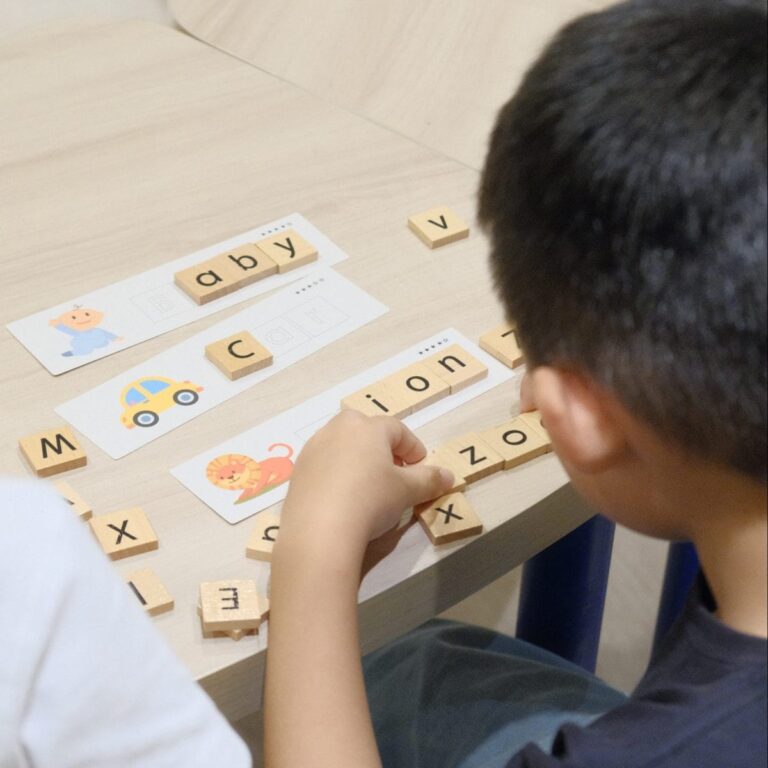
The Importance of Phonics in Developing Reading Skills

In the last century, early literacy education has undergone a paradigm shift in its approach to introducing basic reading skills to children. Whilst some adults today may remember the rote-memorisation (look-say) approach to reading, most educational centres today prioritise phonics as the primary pedagogical tool for young readers. But what exactly is phonics and why is it so popular? How important really is phonics? Read on to find out more!
What is Phonics?
Before we delve too deeply into the fascinating world of phonics, it is essential to understand a few tricky terms. Knowledge of some phonics lingo is bound to come in handy when interacting with your child’s educators, so here’s a rudimentary and digestible crash course in phonics.
The English language is made up of 44* unique sounds known as phonemes. Like many other languages, the letters of the English alphabet can be arranged (singularly or in conjunction with one another) to represent these sounds.
Consider the sound that the letter ‘f’ makes. There are three different ways the ‘f’ sound can occur.
A foundational phonics education first introduces children to these 44 different phonemes and the different ways that they can occur. As they slowly master this, they are gradually introduced to the nuances of segmenting and blending; the heart of basic literacy.
Consider the word ‘dog’. Taken as a block word, some early readers may be stumped as to how to pronounce or spell it. However, a phonics-educated child will realise that the word dog is made up of three distinct sounds and break them up accordingly: (d / o / g). This is known as segmentation. By sequentially sounding out each phoneme, they can then piece the sounds back together and read the word as a whole. This process is known as blending.

Blending and segmenting can also be used by children to reproduce or spell words in their writing that they are not too familiar with. This ability, phonetic spelling, is a powerful tool that allows children to recreate words based on their sounds. Sound recognition, the ability to identify the common letters used to represent a heard phoneme, is often taught in most phonics programme to aid in the development of this skill.
Here is an accessible breakdown of all 44 phonemes in the English language!
| 18 Consonant Phonemes | Almost every consonant in the English alphabet has their own unique phoneme – except the letters x, q, and c. /b/ /d/ /f/ /g/ /h/ /j/ /k/ /l/ /m/ /n/ /p/ /r/ /s/ /t/ /v/ /w/ /y/ /z/ |
| 7 Digraph Phonemes | A digraph phoneme consists of two different consonant phonemes, that when combined, create a singular sound. /ch/ /sh/ /ng/ /zh/ /wh/ /qu/ /th/# |
| 5 Long Vowel Phonemes | Long vowel phonemes are the sounds that vowel letters make when read aloud. /ā/ /ē/ /ī/ /ō/ /ū/ |
| 5 Short Vowel Phonemes | Short vowel phonemes, on the other hand, are the sounds associated with these vowel letters. /a/ /e/ /i/ /o/ /u/ |
| 5 R-Influenced Phonemes | Some vowel phonemes that precede the letter ‘r’ produce entirely different sounds from their short/long vowel counterparts. /a(r)/ /ā(r)/ /i(r)/ /o(r)/ /u(r)/ |
| 2 ‘oo’ Vowel Phonemes | ‘oo’ is a special vowel phoneme that also has long and short vowel variants. /oo/ /ōō/ |
| 2 Diphthongs | A diphthong consists of two different vowel phonemes, that when combined, create a singular sound. /ow/ /oy/ |
Adapted from Orchestrating Success in Reading by Dawn Reithaug (2002)
* The precise number of phonemes may differ based on regional dialects and accents.
#/th/ is ofttimes represented as having sounded and unsounded variants. When taken as two separate phonemes, the number of digraph phonemes can be 8.
Why Join a Phonics Programme?
1) First Step to Reading

Phonics programmes are highly beneficial for children who are just beginning to read, especially if they have difficulties with sounding out their words. Through blending and segmentation, children will find themselves well-prepared to tackle most words they have difficulty with. They will also hone their reading fluency and begin to cultivate a love for reading. Before you know it, your children won’t just be learning to read, they will be reading to learn.
2) Confidence and Independence
With a background in phonics, children are more likely to feel assured and confident in their own reading capabilities. Even as they leave their formal phonics programmes for the next phase in their education, they can still rely on their existing phonics knowledge to navigate through more complex passages and texts.
Additionally, a well-designed programme provides children with a sense of progression and a feeling of accomplishment as they develop their reading stamina and master new concepts.

3) Progressive Learning

A reputable phonics programme will be able to guide your child through complexities of the English language that even native speakers may find confusing. Many children find the grapheme, ‘ea’, to be tricky to sound. For example, why is the ‘ea’ sound pronounced differently in the words, “heart”, “meat”, and “ear”? Some words also defy the rules of phonics (also known as sight words) and need to be learnt through memorization. A seasoned educator will be able to explain these subtleties to your child, and progressively introduce them to more complex concepts at a comfortable but challenging pace.
Final Thoughts
We believe that a foundation in phonics is a powerful tool that gives kids a head start in their literacy. Hence, it is important to integrate phonics into everyday activities so that children can more rapidly assimilate these fundamental skills. Whilst a phonics programme can be an important aspect of early literacy, parents too should apply phonics skills even during regular activities such as story time. Asking simple questions like, “what sound does this letter make?” or, “how do you sound the first letter in this word?” can go a long way towards fostering your child’s reading development.
Wonderlit Read is a niche literacy programme fully-centred around the teaching of phonics. Rooted in synthetic phonics, we make use of reading exercises, educational games, and hands-on activities to engage our children during lessons and promote learning. From the teaching of blending to segmenting, our little ones embark on an exciting reading journey to hone their literacy skills. Through our progressive curriculum, children learn to master the comprehension of basic sentences and paragraphs, eventually conquering fiction and non-fiction texts.
We offer a complimentary literacy assessment for all new students. Each child is assigned to a specific skills-based level in our programme according to their reading abilities. Drop us an enquiry to sign up for your free assessment / trial, or speak to our programme consultants at 6980-5670 (call/WhatsApp).
Recent Posts


How To Nurture Oral Language Development in Children

Story Builders: How Reading Shapes Writing In Kids

4 Fun Ways To Nurture Children’s Love For Performing

Importance of English Phonics for Young Learners

